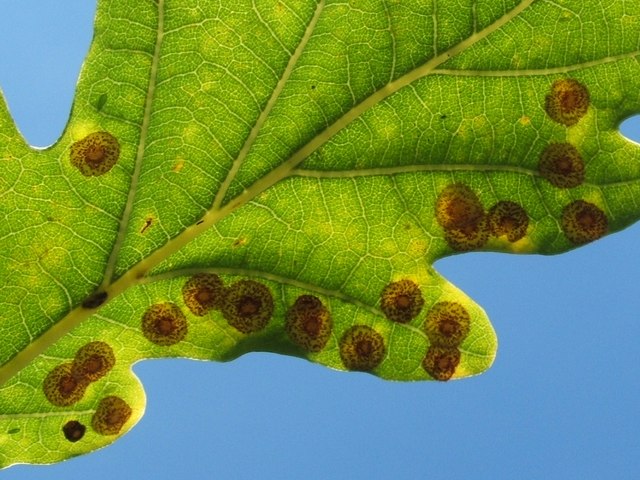Introduction
Galls are abnormal swelling growths that occur on the leaves, twigs, branches, roots, and flowers of plants. A gall’s characteristics are determined by its causal organism. They vary in shape, appearing as balls, knobs, lumps, or warts. Galls display an array of colors, ranging between red, green, yellow, brown, and black. There are 1500 species of gall producers, the majority of which are comprised of insects such as aphids, midges, wasps, and mites. Some galls are the result of bacterial or fungal infections; others are produced by microscopic worms called nematodes. These types of galls can be difficult to distinguish from those created by insects. Many gall producers are host specific.
Galls that develop on leaves are generally an aesthetic problem. Plants that are affected by galls may develop an unsightly appearance, but are otherwise seldom injured. Gall formations can sometimes deform foliage on younger trees. Oaks are one of the most susceptible tree species. They are host to over 500 different wasps, aphids, mites, and midges that cause galls on leaves, branches, and twigs.
Symptoms
Gall formation is recognizable on most plants. Galls appear as abnormal swelling growths that vary in size, shape, and color. Galls that enlarge on smaller plants can interrupt the vascular system, hampering the flow of water and nutrients. This often results in plants becoming stunted, and developing a malformed appearance. Some galls are less apparent, occurring on twigs, small branches, and roots. Over time, they may weaken or kill portions of a plant.
Uses
Galls are rich in resin and tannic acid. As such, they are often used in the manufacturing of permanent inks and astringent ointments. The abundance of tannin present in galls also makes them useful for dyeing and tanning. The larvae in galls make for an effective fishing bait. In many countries, the larvae are utilized as a survival food. Galla chinensis, also known as Chinese gall, is an astringent commonly used in Chinese herbal remedies. The fungus Ustilago esculenta, which is associated with a type of wild rice, produces an edible gall valued as a food source in the Zhejiang and Jiangsu provices of China.
Prevention & Management
- Cultural practices can be employed to prevent gall formation. Rake and destroy fallen leaves from plants that have been affected by galls. Prune and dispose of gall-infested twigs and branches.
- Prevent plants from becoming stressed by ensuring they are sufficiently watered, especially during dry periods.
- Fertilization in spring or summer will help maintain plant vigor.
- Applying a layer of organic mulch around the base of trees and shrubs can improve soil quality, and reduce soil moisture loss. It will also help moderate soil temperature.
- Chemical sprays may be warranted on trees that are in poor health. Sprays will reduce the number of galls and gall-inducing insects, but may also kill beneficial insects. To prevent galls, applications must be made before galls form.
Photo courtesy of Lairich Rig, Creative Commons.


